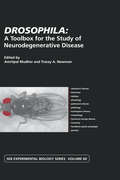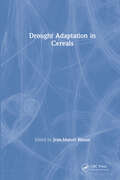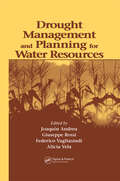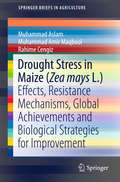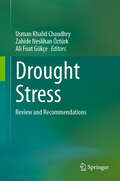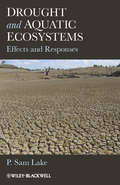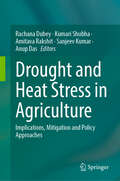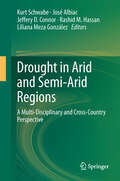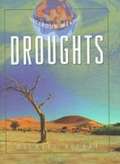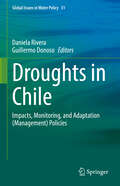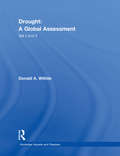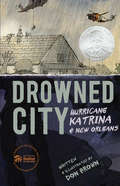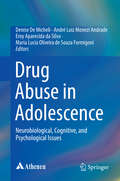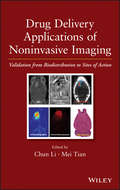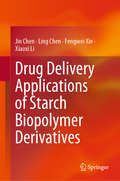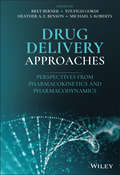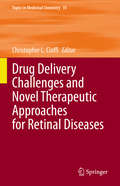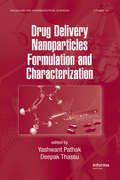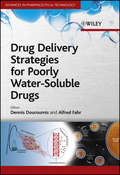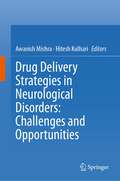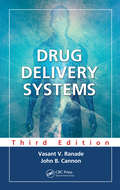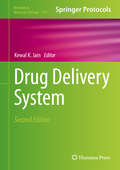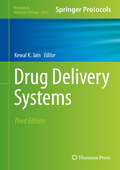- Table View
- List View
Drosophila: Methods and Protocols (Methods in Molecular Biology #2540)
by Christian DahmannThis third edition expands on the previous editions by providing updated protocols and current methods that cover recent breakthroughs in Drosophila research. Chapters guide readers through FlyBase, versatile gene expression systems, analysis of microRNA function, single-cell transcriptome data and metabolism, recent applications of CRISPR for precise genome editing, transcriptional activation and cell lineage tracing, protein inhibition and tagging, optogenetic and optochemical control of tissue mechanics, AFM measurements, sample preparation for electron microscopy, live imaging of different tissues and organs, and quantitative image analysis. Written in the format of the highly successful Methods in Molecular Biology series, chapters include an introduction to their topic, lists of the necessary materials and reagents, step-by-step and readily reproducible laboratory protocols, as well as tips on troubleshooting and avoiding known pitfalls Authoritative and cutting-edge, Drosophila: Methods and Protocols, Third Edition serves as a useful and practical guide to new researchers and experts using Drosophila as a model system.Chapter 7 is available open access under a Creative Commons Attribution 4.0 International License via link.springer.com.
Drosophila: Vol 60 (Society For Experimental Biology Ser.)
by Amritpal MudherDrosophila gives an overview of the ways in which Drosophila is currently being used as a model organism to further our understanding of a spectrum of human neurological diseases. Each chapter is written by respected researchers and gives an excellent account of the subject that is suitable for postgraduate and postdoctoral researchers.
Drought Adaptation in Cereals
by Jean-Marcel RibautLearn how to best improve yield in cereal plants - even in dry conditions.The impact of drought on crop production can be economically devastating. Drought Adaptation in Cereals provides a comprehensive review of the latest research on the tolerance of cereal crops to water-limited conditions. Renowned experts extensively describe basic concepts and cutting-edge research results to clearly reveal all facets of drought adaptation in cereals. More than simply a fine reference for plant biology and plant improvement under water-limited conditions, this book spotlights the most relevant biological approaches from plant phenotyping to functional genomics.The need to understand plant response to the lack of water is integral to forming strategies to best manage crops. Drought Adaptation in Cereals starts by offering an overview of the biological basis and defines the adaptive mechanisms found in plants under water-limited conditions. Different approaches are presented to provide understanding of plant genetics basics and plant breeding, including phenotyping, physiology, and biotechnology. The book details drought adaptation mechanisms at the cellular, organ, and entire plant levels, focusing on plant metabolism and gene functions. This resource is extensively referenced and contains tables, charts, and figures to clearly present data and enhance understanding.After a foreword by J. O'Toole and a prologue by A. Blum, Drought Adaptation in Cereals presents a full spectrum of informative topics from other internationally respected scientists. These include: drought’s economic impact (P. Heisey) genotype-by-environment interactions (M. Cooper) secondary traits for drought adaptation (P. Monneveux) leaf growth (F. Tardieu) carbon isotope discrimination (T. Condon) drought adaptation in barley (M. Sorrells), maize (M. Sawkins), rice (R. Lafitte), sorghum (A. Borrell) and wheat (M. Reynolds) carbohydrate metabolism (A. Tiessen) the role of abscisic acid (T. Setter) protection mechanisms and stress proteins (L. Mtwisha) genetic basis of ion homeostasis and water deficit (H. Bohnert) transcriptional factors (K. Yamaguchi-Shinozaki) resurrection plants (D. Bartels) Drought Adaptation in Cereals is a unique, vital reference for scientists, educators, and students in plant biology, agronomy, and natural resources management.
Drought Management and Planning for Water Resources
by Joaquín Andreu Giuseppe Rossi Federico Vagliasindi Alicia VelaDroughts and their management are a serious challenge to water resource professionals. While droughts predominate in arid regions, their frequency and severity in more temperate regions with more abundant rainfall have been on the rise. Drought Management and Planning for Water Resources provides an essential collection of planning and manag
Drought Stress in Maize (Zea mays L.)
by Muhammad Aslam Muhammad Amir Maqbool Rahime CengizThis book focuses on early germination, one of maize germplasm most important strategies for adapting to drought-induced stress. Some genotypes have the ability to adapt by either reducing water losses or by increasing water uptake. Drought tolerance is also an adaptive strategy that enables crop plants to maintain their normal physiological processes and deliver higher economical yield despite drought stress. Several processes are involved in conferring drought tolerance in maize: the accumulation of osmolytes or antioxidants, plant growth regulators, stress proteins and water channel proteins, transcription factors and signal transduction pathways. Drought is one of the most detrimental forms of abiotic stress around the world and seriously limits the productivity of agricultural crops. Maize, one of the leading cereal crops in the world, is sensitive to drought stress. Maize harvests are affected by drought stress at different growth stages in different regions. Numerous events in the life of maize crops can be affected by drought stress: germination potential, seedling growth, seedling stand establishment, overall growth and development, pollen and silk development, anthesis silking interval, pollination, and embryo, endosperm and kernel development. Though every maize genotype has the ability to avoid or withstand drought stress, there is a concrete need to improve the level of adaptability to drought stress to address the global issue of food security. The most common biological strategies for improving drought stress resistance include screening available maize germplasm for drought tolerance, conventional breeding strategies, and marker-assisted and genomic-assisted breeding and development of transgenic maize. As a comprehensive understanding of the effects of drought stress, adaptive strategies and potential breeding tools is the prerequisite for any sound breeding plan, this brief addresses these aspects.
Drought Stress: Review and Recommendations
by Usman Khalid Chaudhry Zahide Neslihan Öztürk Ali Fuat GökçeThis book offers a thorough examination of how drought stress impacts various facets of a plant's physiology, ecology, and agricultural systems. It delves into the challenges posed by drought stress, a critical issue exacerbated by climate change and its impact on water availability. By employing a multidisciplinary methodology, the book endeavours to furnish a thorough comprehension of the intricate interplay between plants and their surroundings when faced with water scarcity. It proves to be an invaluable asset for scholars, students, policymakers, and experts who are keen on comprehending the intricate array of issues that drought stress poses. Moreover, it serves as a repository of effective strategies to tackle the consequences of drought stress in a world undergoing transformation. The book's multidisciplinary orientation guarantees a comprehensive exploration of the subject, encompassing the physiological, agricultural, and molecular reactions of plants.
Drought and Aquatic Ecosystems: Effects and Responses
by P. Sam LakeDroughts are a major hazard to both natural and human-dominated environments and those, especially of long duration and high intensity, can be highly damaging and leave long-lasting effects. This book describes the climatic conditions that give rise to droughts, and their various forms and chief attributes. Past droughts are described including those that had severe impacts on human societies. As a disturbance, droughts can be thought of as “ramps” in that they usually build slowly and take time to become evident. As precipitation is reduced, flows from catchments into aquatic systems decline. As water declines in water bodies, ecological processes are changed and the biota can be drastically reduced, though species and populations may survive by using refuges. Recovery from drought varies in both rates and in degrees of completeness and may be a function of both refuge availability and connectivity. For the first time, this book reviews the available rather scattered literature on the impacts of drought on the flora, fauna and ecological processes of aquatic ecosystems ranging from small ponds to lakes and from streams to estuaries. The effects of drought on the biota of standing waters and flowing waters and of temporary waters and perennial systems are described and compared. In addition, the ways in which human activity can exacerbate droughts are outlined. In many parts of the world especially in the mid latitudes, global warming may result in increases in the duration and intensity of droughts. Drought and Aquatic Ecosystems is essential reading for freshwater ecologists, water resource managers and advanced students.
Drought and Heat Stress in Agriculture: Implications, Mitigation and Policy Approaches
by Amitava Rakshit Sanjeev Kumar Anup Das Rachana Dubey Kumari ShubhaThis edited book provides critical insights into changing climate's impact on agriculture and innovative strategies for building resilience. The agricultural sector is highly dependent on climatic conditions, is particularly vulnerable to the impacts of drought and heat stress. It has been notices that crop yields in Africa, Asia, and the Middle East are reduced by 15–35% when temperatures rise by 3-4 °C. The book explores the impacts of climate change on agriculture and how farmers can adapt their practices to overcome the dual threat of drought and heat stress on cereals, pulses, oilseeds, vegetables, and other allied sectors. One of the key themes of the book is the importance of smart water management in building agricultural resilience to drought and heat stress. By adeptly managing water resources and nurturing soil health through practices like cover cropping and reduced tillage, farmers bolster their resilience. Additionally, livestock management strategies are explored to combat reduced productivity and health issues due to heat stress. Harnessing the power of AI-assisted solutions, the book showcases how cutting-edge technology aids data-driven decisions on crop management and irrigation. This book is a vital resource for farmers, researchers, policymakers, and those concerned about our food systems' future. It emphasizes the urgent need for climate-smart agricultural policies and technologies, offering prospects for sustainable practices and resilient food production.
Drought in Arid and Semi-Arid Regions: A Multi-Disciplinary and Cross-Country Perspective
by Rashid M. Hassan Kurt Schwabe Jeffery Connor José Albiac Liliana Meza GonzálezOffering a cross-country examination and comparison of drought awareness and experience, this book shows how scientists, water managers, and policy makers approach drought and water scarcity in arid and semi-arid regions of Spain, Mexico, Australia, South Africa and the United States.
Droughts (Dangerous Weather)
by Michael AllabyDucks and geese fell from the sky, choked to death by the dust through which they flew. People called the storms "black blizzards." This was the Dust Bowl of the 1930s, site of one of the worst droughts in history. Perhaps the most insidious and terrifying form of dangerous weather, the absence of rain can bring slow, lingering death to crops, animals, and humans. In Droughts readers will discover why ordinary water is the most precious substance on earth; how global climate change might affect the frequency and severity of droughts; how droughts can occur anywhere; and how to use and conserve water wisely. Stories of droughts past and recent are also recounted. The Dangerous Weather series imparts fundamental weather science to readers through author Michael Allaby's vivid descriptions of extreme weather systems. The series focuses on the five most dangerous kinds of weather activity; diagrams related meteorological, climatological, and environmental basics in clear, compelling language; chronicles the history of each form of dangerous weather; and offers safety precautions for extreme weather conditions. Fully illustrated and indexed, the Dangerous Weather series is an invaluable tool for student research. Other volumes include: blizzards, hurricanes, floods, and tornadoes. Michael Allaby is the author of more than 40 books, mainly on science, natural history, ; environmental topics. A few of his previous works include Basics of Environmental Science, How It Works: The Environment, and The Concise Oxford Dictionary of Ecology. He is a member of the New York Academy of Sciences, among other professional affiliations.
Droughts in Chile: Impacts, Monitoring, and Adaptation (Management) Policies (Global Issues in Water Policy #31)
by Guillermo Donoso Daniela RiveraThe case of Chile is illustrative of a transition from command and control to market-based management policies, where economic incentives play a significant role in water management. This book deals with drought policy in Chile and other countries. It offers a detailed examination of drought management and policies. It describes, analyzes and evaluates the performance of drought policies, laws and institutions, identifies the main challenges that Chile faces and derives lessons learnt. Expert contributors discuss such topics as Chile’s drought water policy, and the reasoning which explains present challenges.
Droughts: A Global Assesment (Books In Soils, Plants, And The Environment Ser. #Vol. 86)
by Donald A. WilhiteDrought draws together contributions from over 75 leading international researchers in the field to present the most comprehensive body of research on the physical and social dimensions of drought to date. Including an extensive range of case-studies covering the most drought-prone and most affected countries, the contributors examine new technology, planning methodologies and mitigation actions from recent drought experiences worldwide.Following a discussion of the critical concepts of drought, the work is divided into the following additional parts:· causes and predictability· monitoring and early warning techniques· impacts and assessment methodologies· links between drought and other global issues· conclusions and future challenges
Droughts: Extreme Weather (Theme Sets)
by Josie GreenDroughts are a form of extreme weather caused by long-term lack of rain in a place that normally gets rain.
Drowned City: Hurricane Katrina and New Orleans
by Don BrownOn August 29, 2005, Hurricane Katrina's monstrous winds and surging water overwhelmed the protective levees around low-lying New Orleans, Louisiana. Eighty percent of the city flooded, in some places under twenty feet of water. Property damages across the Gulf Coast topped $100 billion. One thousand eight hundred and thirty-three people lost their lives. The riveting tale of this historic storm and the drowning of an American city is one of selflessness, heroism, and courage—and also of incompetence, racism, and criminality. Don Brown’s kinetic art and as-it-happens narrative capture both the tragedy and triumph of one of the worst natural disasters in American history. A portion of the proceeds from this book has been donated to Habitat for Humanity New Orleans. <P><P><i>Advisory: Bookshare has learned that this book offers only partial accessibility. We have kept it in the collection because it is useful for some of our members. Benetech is actively working on projects to improve accessibility issues such as these.</i>
Drug Abuse in Adolescence
by Denise Micheli André Luiz Monezi Andrade Eroy Aparecida da Silva Maria Lucia Oliveira de Souza-FormigoniFocusing on two central themes--the psychobiological evolution from youth to adult and the effects of drugs on the developing central nervous system--this important reference elucidates the mechanisms of chemical dependency in adolescents. Its multidisciplinary coverage analyzes addiction across major domains of human functioning against the backdrop of hormonal, cognitive, and other changes that accompany the transition to adulthood. Chapters discuss legal as well as illicit drugs, examine age-related social contexts, and present the latest findings on links between drug use and mental disorders. Throughout, the contributors make clear that education is more valuable to understanding--and preventing--substance abuse than are prohibition and zero-tolerance thinking. Included among the topics: Cognitive development, learning, and drug use. Neurobiology of the action of drugs of abuse. Findings in adolescents with substance dependence based on neuroimaging tests. Alcohol abuse in adolescents: relevance of animal models. Effects of chronic drug abuse on the chronobiology of sleep in adolescents. Neurological and cognitive disorders arising from the chronic use of drugs of abuse. The multiple lenses for understanding its subject and the sensitivity with which causal nuances are treated make Neuroscience of Drug Abuse in Adolescence an invaluable resource for clinical and child psychologists, psychiatrists, social workers, and addiction counselors.
Drug Delivery Applications of Noninvasive Imaging
by Mei Tian Chun LiCost-effective strategies for designing novel drug delivery systems that target a broad range of disease conditionsIn vivo imaging has become an important tool for the development of new drug delivery systems, shedding new light on the pharmacokinetics, biodistribution, bioavailability, local concentration, and clearance of drug substances for the treatment of human disease, most notably cancer. Written by a team of international experts, this book examines the use of quantitative imaging techniques in designing and evaluating novel drug delivery systems and applications.Drug Delivery Applications of Noninvasive Imaging offers a full arsenal of tested and proven methods, practices and guidance, enabling readers to overcome the many challenges in creating successful new drug delivery systems. The book begins with an introduction to molecular imaging. Next, it covers:In vivo imaging techniques and quantitative analysisImaging drugs and drug carriers at the site of action, including low-molecular weight radiopharmaceuticals, peptides and proteins, siRNA, cells, and nanoparticlesApplications of imaging techniques in administration routes other than intravenous injection, such as pulmonary and oral deliveryTranslational research leading to clinical applicationsImaging drug delivery in large animal modelsClinical applications of imaging techniques to guide drug development and drug deliveryChapters are based on a thorough review of the current literature as well as the authors' firsthand experience working with imaging techniques for the development of novel drug delivery systems.Presenting state-of-the-technology applications of imaging in preclinical and clinical evaluation of drug delivery systems, Drug Delivery Applications of Noninvasive Imaging offers cost-effective strategies to pharmaceutical researchers and students for developing drug delivery systems that accurately target a broad range of disease conditions.
Drug Delivery Applications of Starch Biopolymer Derivatives (SpringerBriefs in Molecular Science)
by Jin Chen Xiaoxi Li Ling Chen Fengwei XieThis book summarizes the recent advances in applications of starch in state-of-the-art drug carriers (hydrogel, micro- and nano-particulate carriers) with stimulus-responsive and target-specific properties. It also highlights the role of starch and its derivatives in transmucosal administration to improve the bioavailability of drugs. Further, it outlines the principles of effective, advanced, starch-based drug delivery systems and illustrates how these principles are key to the development of future drug delivery strategies. This interesting reference resource is useful for students, researchers and engineers in the fields of carbohydrate chemistry, polymer sciences and drug delivery.
Drug Delivery Approaches: Perspectives from Pharmacokinetics and Pharmacodynamics
by Bret BernerExplore this comprehensive discussion of the application of physiologically- and physicochemical-based models to guide drug delivery edited by leading experts in the field Drug Delivery Approaches: Perspectives from Pharmacokinetics and Pharmacodynamics delivers a thorough discussion of drug delivery options to achieve target profiles and approaches as defined by physical and pharmacokinetic models. The book offers an overview of drug absorption and physiological models, chapters on oral delivery routes with a focus on both PBPK and multiple dosage form options. It also provides an explanation of the pharmacokinetics of the formulation of drugs delivered by systemic transdermal routes. The distinguished editors have included practical and accessible resources that address the biological and delivery approaches to pulmonary and mucosal delivery of drugs. Emergency care settings are also described, with explorations of the relationship between parenteral infusion profiles and PK/PD. The future of drug delivery is addressed via discussions of virtual experiments to elucidate mechanisms and approaches to drug delivery and personalized medicine. Readers will also benefit from the inclusion of: A thorough introduction to the utility of mathematical models in drug development and delivery An exploration of the techniques and applications of physiologically based models to drug delivery Discussions of oral delivery and pharmacokinetic models and oral site-directed delivery A review of integrated transdermal delivery and pharmacokinetics in development An examination of virtual experiment methods for integrating pharmacokinetic, pharmacodynamic, and drug delivery mechanisms Alternative endpoints to pharmacokinetics for topical delivery Perfect for researchers, industrial scientists, graduate students, and postdoctoral students in the area of pharmaceutical science and engineering, Drug Delivery Approaches: Perspectives from Pharmacokinetics and Pharmacodynamics will also earn a place in the libraries of formulators, pharmacokineticists, and clinical pharmacologists.
Drug Delivery Challenges and Novel Therapeutic Approaches for Retinal Diseases (Topics in Medicinal Chemistry #35)
by Christopher L. CioffiThis book reviews the current state of ocular drug therapy and future therapeutic opportunities for a wide variety of conditions, including Age-related Macular Degeneration, Diabetic Retinopathy and Macular Edema, Glaucoma, and Inherited Retinal Diseases.Retinal diseases are major contributors to moderate or severe vision impairment in adults aged 50 years and older. The respective patient populations for many of these indications is expected to significantly increase as the world population continues to grow older. An improved understanding of the etiological underpinnings of ocular degenerative diseases over the past decade has significantly bolstered ophthalmic drug discovery.In this volume, contributions from leading experts explore the unique challenges faced for ocular drug discovery and delivery providing the reader with detailed information on ocular pharmacokinetics, in vitro, ex vivo and in vivo models for retinal disease pathology and emerging gene therapy treatments. The book is intended for all researchers and clinicians who wish to increase their knowledge on the latest findings in ocular drug therapy.
Drug Delivery Nanoparticles Formulation and Characterization (Drugs and the Pharmaceutical Sciences)
by Yashwant Pathak Deepak ThassuExploring fundamental concepts, Drug Delivery Nanoparticles Formulation and Characterization presents key aspects of nanoparticulate system development for various therapeutic applications and provides advanced methods used to file for regulatory approval.This comprehensive guide features:Process Analytical Techniques (PAT) used in manufacturing Na
Drug Delivery Strategies for Poorly Water-Soluble Drugs
by Dionysios Douroumis Alfred FahrMany newly proposed drugs suffer from poor water solubility, thus presenting major hurdles in the design of suitable formulations for administration to patients. Consequently, the development oftechniques and materials to overcome these hurdles is a major area of research in pharmaceutical companies.Drug Delivery Strategies for Poorly Water-Soluble Drugs provides a comprehensive overview of currently used formulation strategies for hydrophobic drugs, including liposome formulation, cyclodextrin drug carriers, solid lipid nanoparticles, polymeric drug encapsulation delivery systems, self-microemulsifying drug delivery systems, nanocrystals, hydrosol colloidal dispersions, microemulsions, solid dispersions, cosolvent use, dendrimers, polymer- drug conjugates, polymeric micelles, and mesoporous silica nanoparticles. For each approach the book discusses the main instrumentation, operation principles and theoretical background, with a focus on criticalformulation features and clinical studies. Finally, the book includes some recent and novel applications, scale-up considerations and regulatory issues.Drug Delivery Strategies for Poorly Water-Soluble Drugs is an essential multidisciplinary guide to this important area of drug formulation for researchers in industry and academia working in drugdelivery, polymers and biomaterials.
Drug Delivery Strategies in Neurological Disorders: Challenges and Opportunities
by Hitesh Kulhari Awanish MishraThis book comprehensively reviews the recent progress in their pathogenesis and management approaches for neurological disorders. It focuses on understanding the molecular mechanism, pathology, novel nanotechnology-based approaches against stroke, Alzheimer’s disease, Parkinson disease, Huntington’s disease, Multiple sclerosis, and Epilepsy. The book provides the basic understanding about the development and progression of these diseases, and recent pharmacotherapeutic approaches for their management. It also discusses challenges in drug development for neurological disorders, including preclinical models of disorders, the need for drugs to cross the blood-brain-barrier, and limited understanding of relevant pathophysiology. The book also focuses on different conventional and novel strategies for drug delivery in neurological disorders. Towards the end, the book reviews the applications of nanotechnology for the diagnosis of neurological disorders. One of the chapters is focused onthe role of herbal actives in the treatment of neurological disorders. Finally, a chapter is included on nanotechnology-based approaches for diagnosis of neurological disorders. This book is a useful resource for students and researchers of pharmaceutical sciences, life sciences, material sciences, and nanosciences.
Drug Delivery Systems
by Vasant V. Ranade John B. CannonDrug delivery technologies represent a vast, vital area of research and development in pharmaceuticals. The demand for innovative drug delivery systems continues to grow, driving a variety of new developments. Drug Delivery Systems, Third Edition provides a comprehensive review of the latest research and development on drug delivery systems.Coverag
Drug Delivery Systems
by Kewal K. JainIn this concise and systematic book, a team of experts select the most important, cutting-edge technologies used in drug delivery systems. They take into account significant drugs, new technologies such as nanoparticles, and therapeutic applications. The chapters present step-by-step laboratory protocols following the highly successful Methods in Molecular BiologyTM series format, offering readily reproducible results vital for pharmaceutical physicians and scientists.
Drug Delivery Systems (Methods in Molecular Biology #2059)
by Kewal K. JainThis third edition volume expands on the previous editions with a discussion of new and updated methods used to study drug delivery. Chapters cover topics such as drug delivery in cancer and intrathecal delivery of analgesics in humans. The increasing role of nanobiotechnology is reflected in eight of the sixteen chapters that include synthesis of gold nanoparticles; targeted siRNA delivery; and lipid nanocarriers. Written in the highly successful Methods in Molecular Biology series format, chapters include introductions to their respective topics, lists of the necessary materials and reagents, step-by-step, readily reproducible laboratory protocols, and tips on troubleshooting and avoiding known pitfalls.Authoritative and thorough, Drug Delivery Systems: Methods and Protocols, Third Edition is a valuable resource for scientists working in industry or academia, and physicians involved in research and clinical care of patients.

